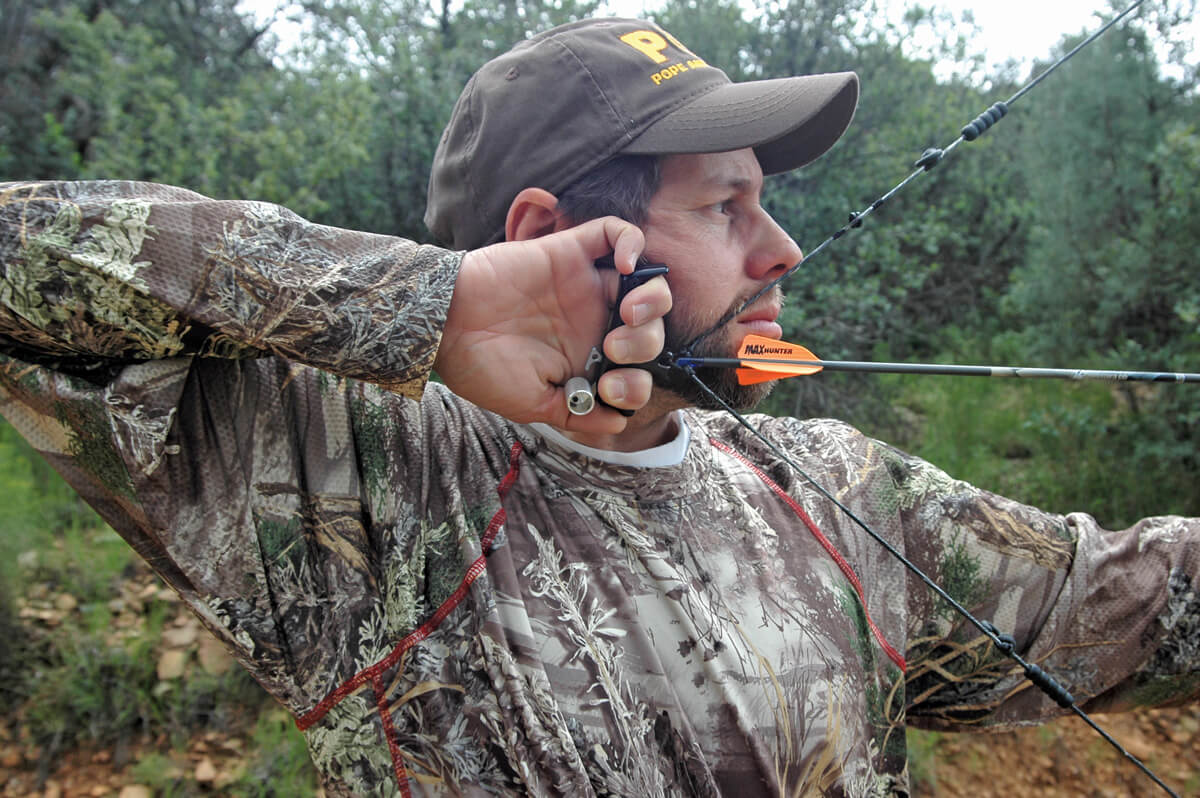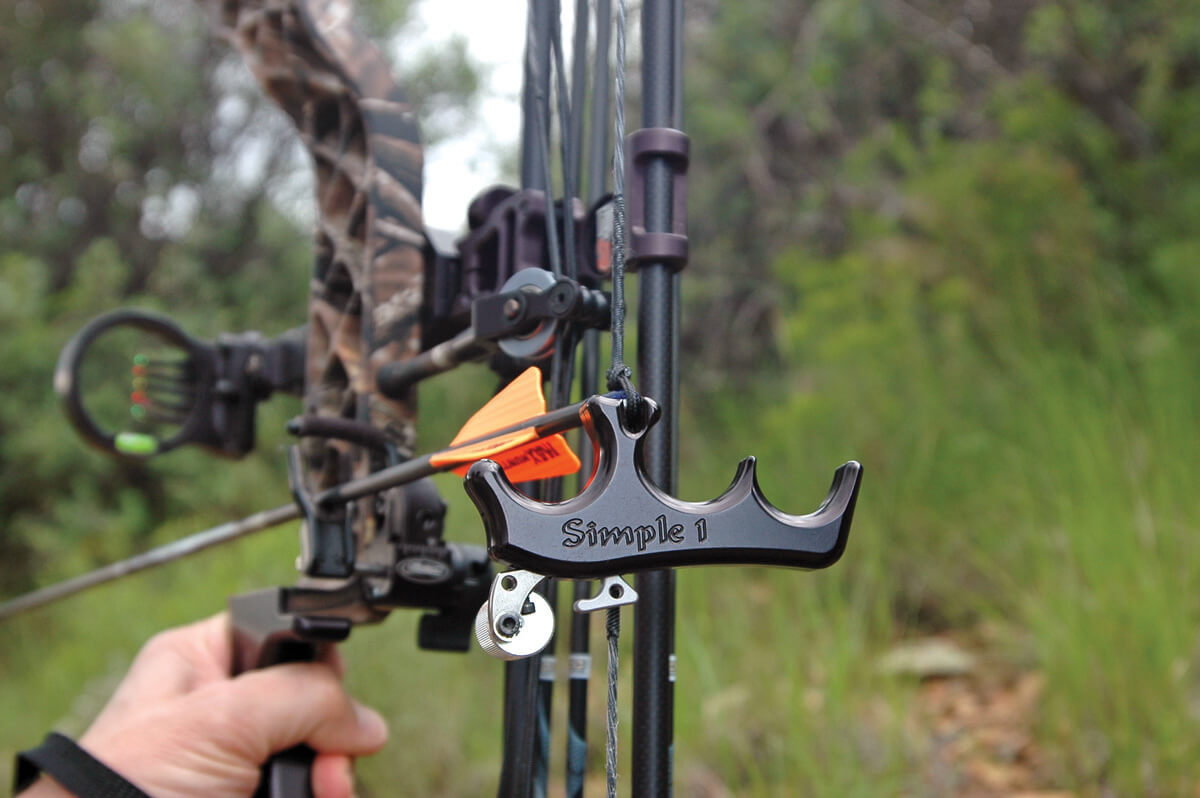
Because your thumb is less sensitive than your index finger, this style of release improves aiming focus, quickly making you a better shot.
There’s been a wave of bowhunters jumping on the thumb-release bandwagon. What’s this all about? Well, it seems this group of bowhunters is discovering they shoot much more consistently with a handheld thumb release than with a wrist-strap, index-finger release. The reason is simple: The thumb is inherently less sensitive to trigger feel, and this is what’s needed to free the archer’s mind for precision shooting.
On the other hand, the index finger is super-sensitive to trigger feel, making it easier to anticipate the shot. Aiming becomes harder, too. From there, it’s easy for the shot to start breaking down to the point where shooting becomes a complete disaster. But the thumb release can help break this improper shooting cycle.
In the following sections, I’ll outline three convincing points for using a thumb release. Then I’ll provide some helpful tips on how to shoot this style of release correctly.
Reprogram The Shot
A thumb-trigger release will immediately change how the shot feels. Drawing your bow will feel a little different. The draw anchor will feel different and a little clumsy, too. All your fingers will be curled around the release’s handle, which means full contact with the release using your entire hand — not just a single point of contact with your “twitchy” pointer finger.
All these differences add up to using different muscle groups and memory through the act of repetition. This is normal and a complete blessing, because you now have the chance to rebuild the entire shot execution until it’s perfect.
To ensure the right type of programming, you must stay disciplined and use good shooting form. Take it slow, and be methodical in how you rebuild your shot sequence. Let the sight pin “float around” on the target’s spot. Do not try to keep it motionless, because that’s impossible for anyone to do. Let it slowly move around the bull’s-eye until the shot just happens. It’s critical that you stay relaxed while aiming intently. If you do this over and over, you’ll eliminate bad habits and acquire a brand-new way of shooting.
Improves Muscle Mechanics
Since your draw hand is in full contact with the release, the mechanics of the anchor will be different. Your hand and wrist will be straighter because the tension of the bowstring is forcing the release’s handle in proper alignment. Your hand will also pivot vertically to some degree as you anchor on your jawbone using the “web” of your thumb and index-finger knuckles. With this position, your thumb is pointed down and your pinky finger is pointed up. Hand position depends solely on what feels comfortable. Regardless, the overall position of your hand now makes it easier to use your rhomboid muscles to hold and even activate the shot.
A Crisp, Clean Shot
Not all thumb releases are created equal. However, a good one will have a polished double-sear system that provides a tremendously crisp trigger. This type of release exhibits no perceptible trigger movement — meaning no creep. If the release has trigger creep, it will create a huge distraction: Your mind will be drawn away from aiming to thinking about what the trigger is doing. Once this happens, the quality of the shot will decay. Then, in due time, anticipating the shot and punching the trigger again becomes a problem.
It’s important to let the arrow fire on its own. Our job is simple: Aim, aim, and aim until the shot breaks. Through repetition and muscle memory, “triggering” the shot is simply a job for the subconscious — not the conscious.
Carter, Scott, Spot Hogg, Stanislawski, T.R.U. Ball, TruFire, and others all make quality thumb releases with creep-free triggers. There are many styles available to accommodate different hand sizes and anchor preferences.
One of the best places to sample releases is at a well-stocked pro shop, or at a major archery tournament where manufacturer vendors are available. Using a simple string bow (an old bowstring or cord tied in a knot that allows you to brace one end against your palm while pulling on the other end with your release), you can sample different releases, triggering each once to find the right feel.
Thumb-Trigger Shooting Tips
Grip The Trigger Indirectly: When shooting a thumb release, try placing the tip of your thumb on the release’s body, while the knurled trigger rests near the “meaty” knuckle area of your thumb. This position, given the trigger knob is adjusted correctly, allows you to depress the trigger not by moving the thumb itself but by relaxing the back of your hand and allowing the handle to naturally rotate downward to activate the trigger. Shooting this way mimics the same mechanics you’d use with a hinge or triggerless back-tension release. This promotes maximum control, repeatability, and eliminates the chance of anticipating the shot.

Relax The Hand: It’s critical to relax your hand when using a thumb release. If not, you’ll grip the handle differently each time and even disrupt the alignment of your wrist with the bowstring, creating varying degrees of torque on the D-loop.
To establish a relaxed hand, grip the release’s handle between the second and third knuckles of your hand. This creates a solid “hook” and will minimize muscle tension compared to holding the handle with the tips of your fingers. Once you hit anchor and acquire the target, send a mental cue to relax your fingertips, and the remainder of the shot will take care of itself. Don’t worry about the release flying out of your hand, because it won’t! The way the release’s body is shaped allows it to stay solidly cupped inside your fingers and palm region.
Establish A Consistent Anchor: Some archers prefer to pivot their hand 45 degrees; others pivot it up to 90 degrees to get the right feel at anchor. Establish whatever position feels best to you.
To make small adjustments in draw length without affecting how the bowstring crosses your nose and face, vary the length of your D-loop. Keep in mind, when using a handheld release, it’s better to shoot a slightly longer D-loop that allows some degree of twisting, because you’ll have to pivot your hand somewhat to find a solid anchor. If the loop is too short, it could torque the bowstring and cause tuning and accuracy issues. For best results, try to keep the loop’s inner length from the bowstring’s surface a full 5⁄8 inches or longer.
When done right, switching to a thumb release can be a complete game-changer. You’ll shoot much more consistently and with greater confidence. Your performance on the shooting line or in the field will simply be a byproduct of your new shooting style. This might be just what you need to enjoy archery all over again and to hang more trophies on the wall. Give it a shot!
The author works on perfecting his technical archery know-how from his home near Prescott, Arizona.


